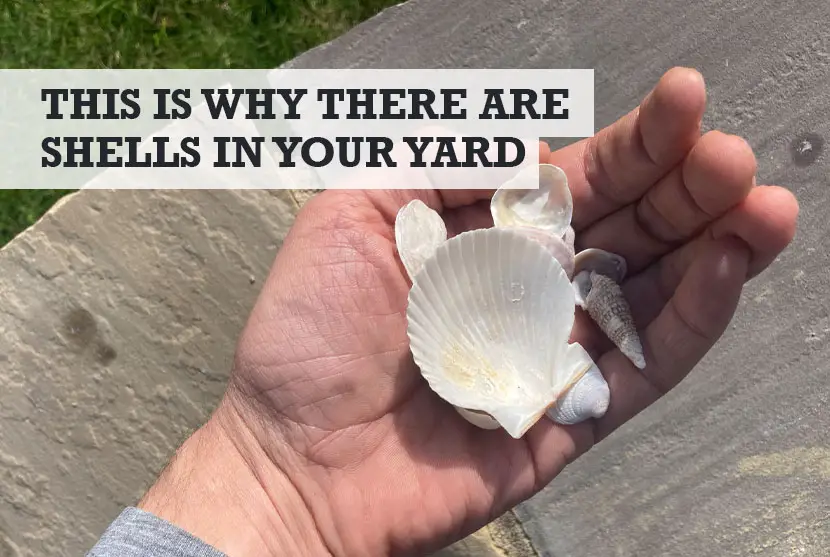Last summer I started an ambitious garden project. When I started turning over soil and cutting back grass, I started to find what looked like seashells in my backyard. It confused me, as we live 5 miles away from the coast, so why were there shells in my garden?
It didn’t take long for me to figure it out though with the help of some online research. Here’s what I discovered about finding shells in your backyard.
Why are there seashells in my backyard? You will find shells in your garden or backyard due to reasons as diverse as being transferred by animals, the wind carries them, or shells could possibly be remnants from a previous gardener using them in the backyard.
That’s a short answer, but there’s a bit more to it below. Plus, I also have some tips on how you can put those seashells in your garden to good use!
Why are there shells in my garden?
If you live near the coast, you might have spent time collecting seashells with kids, or as a kid. However, if you live inland with no access to the sea, just how do seashells end up in your backyard or garden?
Well, as I’ve already touched on, there are many ways that shells can find their way into your garden from the coast – here’s more detail on how that happens.
1. An animal brought the shells into your backyard
I will start with the most common way in which shells get into your garden or backyard: animal transfers. Some animals are known to carry seashells with them on their migration routes inland after they have eaten the contents of the shell.
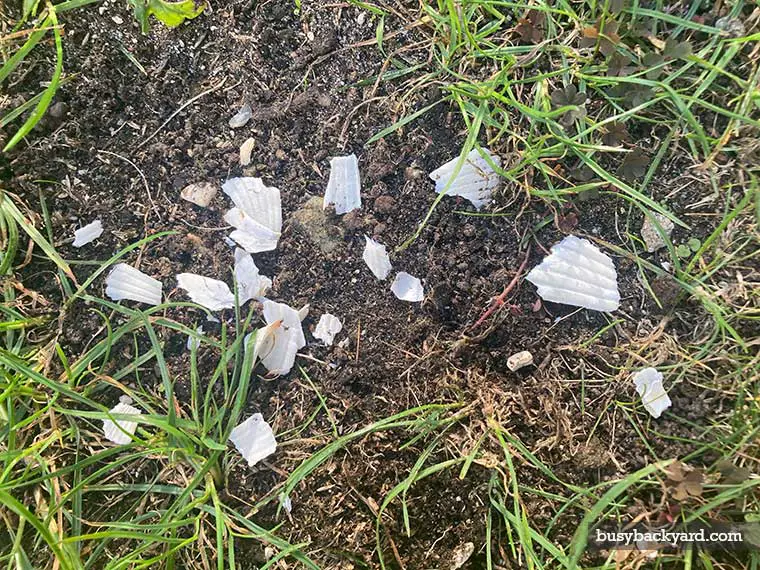
Snails are one example of this type of transfer. Gastropods can span great distances by hitching rides on large animals that roam through different regions. Gastropods travel in two ways: either attached to predators or inside live tissue.
The first way gastropod hitchhikers get around is by attaching themselves to larger creatures such as turtles, birds, and even humans. The second method is called parataxis, where a slug will leave its trail on vegetation while crawling towards food sources, allowing other snails to detect new food sources and to lay their trails.
Snails also attach themselves to other prey, such as dead fish and birds. So, if you have a snail problem in your yard, these gastropods may be moving from the coasts into inland areas by hitching rides on animals.
2. The wind can carry shells into your backyard
Wind can be another means of moving seashells from the coast to inland areas such as your backyard garden. In this scenario, high winds pick up shells from coastal regions and deposit them far inland, depending on the direction of wind flow.
These hurricanes, typhoons, and tropical storms move the shells much farther than a normal breeze could do alone due to strong gusts combined with long periods of time for transport.
The average hurricane moves at a speed of about 20 kilometers per hour. Much higher speeds have been recorded, but these are not representative of typical conditions.
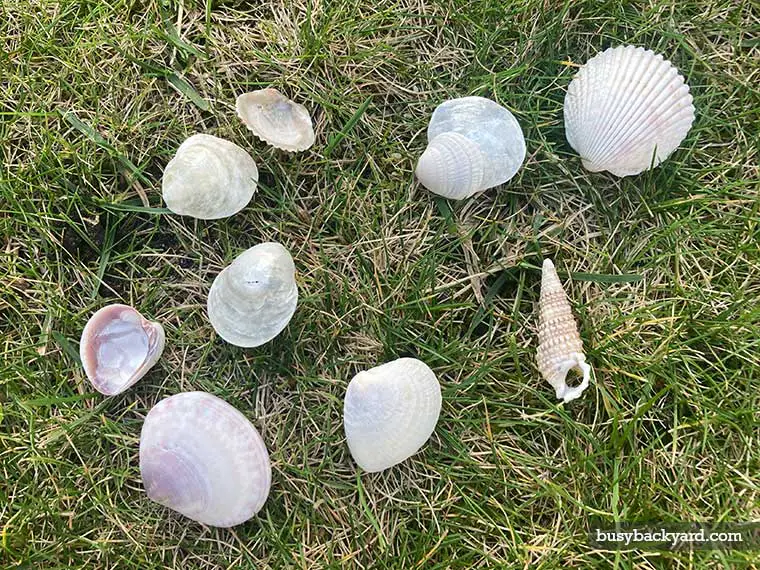
However, this is enough to transport a shell a great distance if the time frame is long enough. Hurricane Katrina, for instance, could have easily carried seashells from the coast into inland regions due to its average speed and unpredictable path.
The result, after a storm has passed, is a very different shoreline than before. The energy of water is awesome in its ability to move sediment from one place and deposit in another.
Shoreline Effects of Storms, https://www.e-education.psu.edu/earth107/node/1519
3. The shells found their way into your garden from a human hand
I also want to mention that humans contribute to the transfer of seashells to inland environments such as your yard. Humans are, unfortunately, both collectors and destroyers of shells. Sometimes, they do it for fun; others do it because their livelihood depends on it (for example, if their job involves collecting shellfish).
This is common in regions where there is a high demand for seashells in aquariums, jewellery, etc. You may have found some sand dollars in your yard due to human activities!
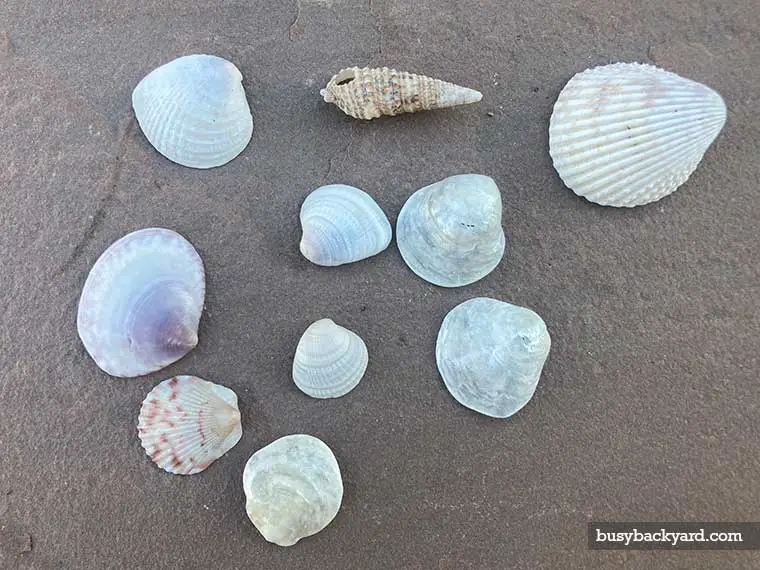
I know for a fact that each time my wife and son go on a playdate to the beach, he will come back with shells which somehow end up in our garden. Perhaps the same is happening in your backyard with seashells?
Handy Hint: You might also find empty snail shells in your backyard. There are different reasons why empty snails shells appear in gardens.
4. Another natural phenomenon could have transferred the shells
Whilst wind and animals are two of the most frequent ways that seashells end up in backyards and gardens, nature can also play a role in moving them around. Natural phenomena such as waves can push shells far inland, just like wind can.
Waves are much more effective than wind because their speed is greater and can last longer.
Waves, however, may only travel tens of meters before the energy dissipates. This means that waves are not very efficient ways of moving seashells to inland regions.
5. Another weather incident might have put shells in your backyard
Other weather incidents can also play a role in transferring shells from the coast to inland regions due to the erosion caused by storms. Winds blowing towards the coast will carry particles away from coastal regions, where they can be deposited into nearby streams or rivers, which eventually flow into other bodies of water.
These particles include seashells that have been broken apart by physical processes such as crashing waves interacting with rocks on shorelines.
Chipped shells making their way into the water can be transported inland when wind and weather carry particles away from coastal regions.
6. Shells could be in your backyard from a previous gardening or construction project
Something that will often be overlooked is how shells could appear in your backyard due to the activity of a previous tenant or homeowner.
Seashells can be used in gardening, as when crushed up they work as a natural fertilizer which helps to enrich the soil. Other gardeners will use shells as a decorative feature.
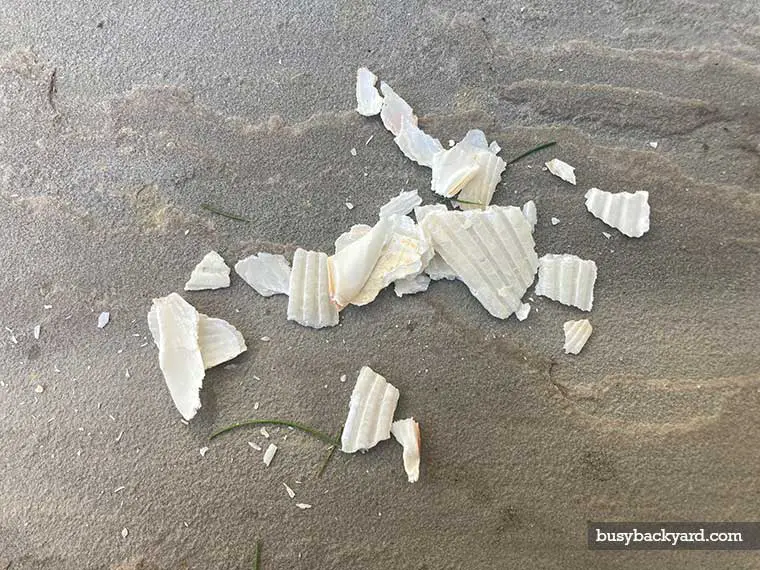
Another possibility could be from construction. If a firm has used gravel and pebble from a coastal area to help with the build of your home, you might find shell debris in the backyard for years to come.
Handy Hint: See how gardeners can use oyster shells as a fertilizer.
7. They could be the remains of crushed up snail shells
And lastly, have you considered that the shells in your garden could be the remnants of crushed snail shells? Rats will eat snails but leave the shell behind.
More about finding seashells in your backyard
I hope that’s helped answer your questions on how shells end up being found in backyards, but as promised, there are things you can do with those shells once you find them.
Can you use seashells for gardening?
Yes, you can use seashells for gardening! According to my research, calcium and magnesium are good for your soil and help plants grow faster and bigger. The shells also break down into smaller pieces that allow water and air into the soil.
It is important to remember that seashells will change the pH of your soil. Since most garden vegetables prefer slightly acidic soil, you might want to mix seashells with compost or other organic matter that will help offset this effect.
Can you use seashells as fertilizer?
Yes, you can use seashells as compost or fertilizer. You can add the shells into a pile with some other compost materials, and it should break down quickly. I think adding shellfish to your garden would be cool because they have calcium and magnesium!
Whenever you use seashells as fertilizer, it is important to remember the pH level of your soil. You may add calcium and magnesium, but if your soil is too alkaline, it won’t be good for plant growth.
How can you decorate a garden with seashells?
You can do landscaping with seashells by putting them in a stone garden. I think it would be cool! You could also add shells to your compost bin or pile if you want to add calcium and magnesium into the soil. It is important to remember that adding too many shells will raise the pH level of your soil.
When doing landscaping with seashells, moderation is key!
Are seashells good or bad luck?
It is essential to remember that over time, the shells will break down and disappear. But if you have a lot of seashells in your garden over a short amount of time, it is likely they may be adding too much calcium and magnesium into your soil.
Well, according to my research, I think they are good luck. That’s because many people who live by the beach collect seashells and keep them in their houses as decoration or for whatever reason!
Conclusion
They can be transferred by animals, weather, and humans, for instance. In this article, I will present ways that seashells are moved from their original homes on the coasts to inland areas, and I will discuss which methods are the most frequent.

